pep小学英语介词归纳
小学一年级英语介词的知识点
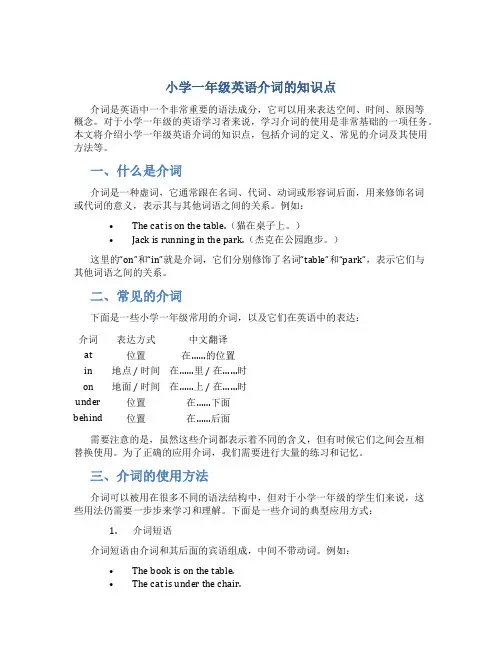
小学一年级英语介词的知识点介词是英语中一个非常重要的语法成分,它可以用来表达空间、时间、原因等概念。
对于小学一年级的英语学习者来说,学习介词的使用是非常基础的一项任务。
本文将介绍小学一年级英语介词的知识点,包括介词的定义、常见的介词及其使用方法等。
一、什么是介词介词是一种虚词,它通常跟在名词、代词、动词或形容词后面,用来修饰名词或代词的意义,表示其与其他词语之间的关系。
例如:•The cat is on the table.(猫在桌子上。
)•Jack is running in the park.(杰克在公园跑步。
)这里的“on”和“in”就是介词,它们分别修饰了名词“table”和“park”,表示它们与其他词语之间的关系。
二、常见的介词下面是一些小学一年级常用的介词,以及它们在英语中的表达:介词表达方式中文翻译at 位置在……的位置in 地点 / 时间在……里 / 在……时on 地面 / 时间在……上 / 在……时under 位置在……下面behind 位置在……后面需要注意的是,虽然这些介词都表示着不同的含义,但有时候它们之间会互相替换使用。
为了正确的应用介词,我们需要进行大量的练习和记忆。
三、介词的使用方法介词可以被用在很多不同的语法结构中,但对于小学一年级的学生们来说,这些用法仍需要一步步来学习和理解。
下面是一些介词的典型应用方式:1.介词短语介词短语由介词和其后面的宾语组成,中间不带动词。
例如:•The book is on the table.•The cat is under the chair.2.时间介词时间介词表示某个动作或事件发生的时间,可以用来回答“什么时候”的问题。
例如:•I usually go to bed at 10 o’clock.•We have English class on Monday.3.地点介词地点介词用来描述某个事物或人所处的位置,可以用来回答“在哪里”的问题。
最新人教pep版小学英语毕业专项复习——第二部分 词类梳理 第六节介词和连词

2. be+形容词+介词
be afraid of 害怕 be angry with 生气 be close to 接近于
be famous for 因……出名
be full of 充满
be good at 擅长于 be proud of 为……感到自豪
be short of 缺乏 be late for 迟到……
返回目录
2. above, over, on above:意为“在……上方”,不强调是否正对,与 below相对应。
如: The bird is flying above my head.小鸟在我头上飞。 over:意为“在……正上方”,与under相对应,与物体之间不直 接接触。如: There is a bridge over the river. 河上有一座桥。 on:表示在某物体上面并与之接触,其对应词也是under。如: His watch is on the desk. 他的手表在桌子上。
返回目录
五、常见连词及其用法 1. and意为“和”。如: I like cabbages and carrots. 我喜欢卷心菜和胡萝卜。 2. both … and … 意为“……和……(两者)都……”。如: Both you and I are in Class Six this year. 今年我和你在都在六班。
返回目录
2. in, after in:“in+一段时间”表示在将来的一段时间的以后。如:
My mother will come back in three days. 我妈妈将会在三天后回来。 after:“after+一段时间”表示在过去的一段时间的以后。如:
He arrived in Beijing after five months. 在五个月之后他到达了 北京。 “after+将来的时间点”表示在将来的某一时刻以后。如: She will come after five o'clock this afternoon. 她会在今天下午五 点钟之后来。
新版PEP小学英语五年级上册复习方位介词和there be句型
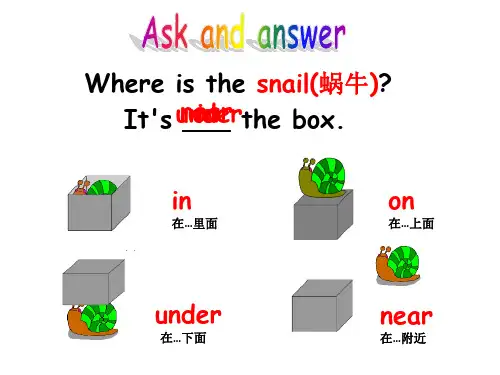
一、单项选择:
1、--Is there a house beside the river? -- ____B___ .
A.Yes, there are. B. No, there isn’t. C.Yes, it is.
2、--Is this a building? -- ___A____ .
A. Yes, there is. B. Yes, it is. C. No, there isn’t. 3、__C___ there any trees in the village?
Let’s go to the nature park! What’s in the nature park?
There is a forest beside the mountain. There is a mountain in the nature park.
There is a lake in front of the mountain. There is a river near the mountain.
用There be句型描述城市景物所在的位置:
Let’s go to the city! What’s in the city?
There are many buildings in the city.
There are many cars in the city.
把There be 句型改为一般疑问句,先要找出be动 词(am, is, are)调到开头,改大小写,其它照抄,句 号改问号。如果句中有some 要变成any。
A. are
B. Is
C. Are
4、There is mountain __B___ the nature park.
小学英语介词总结
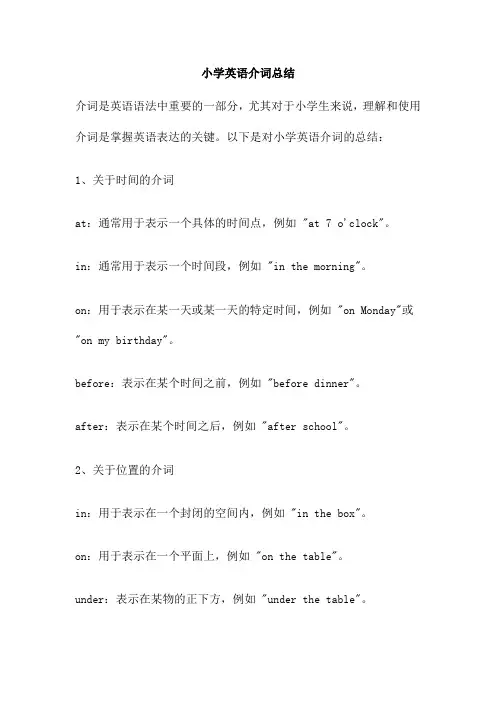
小学英语介词总结介词是英语语法中重要的一部分,尤其对于小学生来说,理解和使用介词是掌握英语表达的关键。
以下是对小学英语介词的总结:1、关于时间的介词at:通常用于表示一个具体的时间点,例如 "at 7 o'clock"。
in:通常用于表示一个时间段,例如 "in the morning"。
on:用于表示在某一天或某一天的特定时间,例如 "on Monday"或"on my birthday"。
before:表示在某个时间之前,例如 "before dinner"。
after:表示在某个时间之后,例如 "after school"。
2、关于位置的介词in:用于表示在一个封闭的空间内,例如 "in the box"。
on:用于表示在一个平面上,例如 "on the table"。
under:表示在某物的正下方,例如 "under the table"。
above:表示在某物的上方,但是不一定是正上方,例如 "above the table"。
beside:表示在某物的旁边,例如 "beside the book"。
3、关于方向的介词to:用于表示朝向某个方向或地点,例如 "go to school"。
from:用于表示从一个地方或位置到另一个地方或位置,例如 "come from school"。
towards:表示朝向某个方向或地点,但是不一定到达那里,例如"walk towards the park"。
4、关于原因的介词because:用于表示原因或理由,例如 "I am late because I missed the bus"。
小学的归纳与解析常见介词的用法和搭配规则
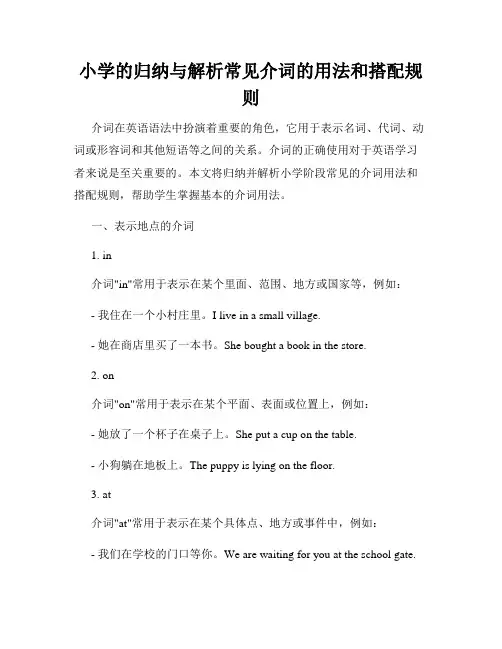
小学的归纳与解析常见介词的用法和搭配规则介词在英语语法中扮演着重要的角色,它用于表示名词、代词、动词或形容词和其他短语等之间的关系。
介词的正确使用对于英语学习者来说是至关重要的。
本文将归纳并解析小学阶段常见的介词用法和搭配规则,帮助学生掌握基本的介词用法。
一、表示地点的介词1. in介词"in"常用于表示在某个里面、范围、地方或国家等,例如:- 我住在一个小村庄里。
I live in a small village.- 她在商店里买了一本书。
She bought a book in the store.2. on介词"on"常用于表示在某个平面、表面或位置上,例如:- 她放了一个杯子在桌子上。
She put a cup on the table.- 小狗躺在地板上。
The puppy is lying on the floor.3. at介词"at"常用于表示在某个具体点、地方或事件中,例如:- 我们在学校的门口等你。
We are waiting for you at the school gate.- 她在图书馆参加了一个讲座。
She attended a lecture at the library.二、表示时间的介词1. in介词"in"常用于表示在某个时间段或月份中,例如:- 我在冬天喜欢滑雪。
I enjoy skiing in winter.- 我们将在十二月举办一次聚会。
We will have a party in December.2. on介词"on"常用于表示在某个具体日期或星期几,例如:- 他们将在星期五晚上去看电影。
They will go to the movies on Friday night.- 我的生日是在七月二十一日。
My birthday is on July 21st.3. at介词"at"常用于表示在某个具体时间点,例如:- 晚上九点钟我会在家里等你。
英语之介词的用法(讲义)人教PEP版英语六年级下册
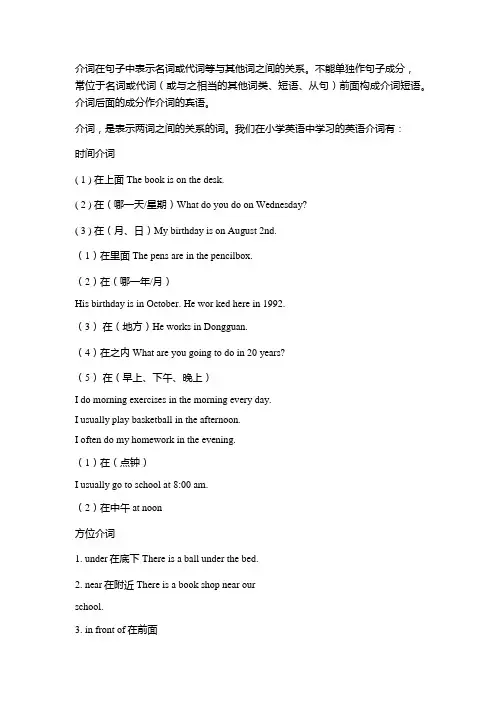
介词在句子中表示名词或代词等与其他词之间的关系。
不能单独作句子成分,常位于名词或代词(或与之相当的其他词类、短语、从句)前面构成介词短语。
介词后面的成分作介词的宾语。
介词,是表示两词之间的关系的词。
我们在小学英语中学习的英语介词有:时间介词( 1 ) 在上面The book is on the desk.( 2 ) 在(哪一天/星期)What do you do on Wednesday?( 3 ) 在(月、日)My birthday is on August 2nd.(1)在里面The pens are in the pencilbox.(2)在(哪一年/月)His birthday is in October. He wor ked here in 1992.(3)在(地方)He works in Dongguan.(4)在之内What are you going to do in 20 years?(5)在(早上、下午、晚上)I do morning exercises in the morning every day.I usually play basketball in the afternoon.I often do my homework in the evening.(1)在(点钟)I usually go to school at 8:00 am.(2)在中午at noon方位介词1. under在底下There is a ball under the bed.2. near在附近There is a book shop near ourschool.3. in front of在前面A boy is standing in front of the house.4. beside在旁边A football is beside thedoor.5. next to紧挨着There is a bus station next to No. 13 Middle School.6. over在正上方A bridge is over the river.7. on the left在左边The bookstore is on the left.8. on the right在右边The hospital is on the right.9. before在……之前Mike sits before me.10. after在以后He went home after school.11. in the middle在中间The road is in the middle.12. at(1)在(小地方)I am at school today.I was at home yesterday.(2)看一看Look at the blackboard.13. behind在后面There is a broom behind the door.其他常用介词(1)给。
新版PEP小学英语3-5年级介词分类
新版PEP小学英语3-5年级介词分类本文档旨在帮助学生更好地理解和运用介词,为他们研究和掌握英语语法打下坚实的基础。
下面是对介词的分类和常见例子的详细介绍。
一、地点介词地点介词用来表示一个人或物体所在的位置。
常见的地点介词有:- in:在某个范围内,如in the park(在公园里)- on:在某个表面上,如on the table(在桌子上)- at:在某个具体位置,如at the bus stop(在公交车站)- under:在某物下面,如under the bed(在床底下)- behind:在某物后面,如behind the door(在门后面)二、时间介词时间介词用来表示事件发生的时间。
常见的时间介词有:- at:在具体时刻,如at 3 o'clock(在3点)- on:在某一天或日期,如on Monday(在星期一)- in:在某个时间段,如in the morning(在早上)- during:在某个时间段内,如during summer vacation(在暑假期间)- after:在某个时间点之后,如after school(放学后)三、方向介词方向介词用来表示运动或定位的方向。
常见的方向介词有:- to:表示朝向某个地点,如go to school(去学校)- into:表示进入某个地点,如go into the room(进入房间)- out of:表示离开某个地点,如get out of the car(下车)四、方式介词方式介词用来表示做事情的方式或手段。
常见的方式介词有:- by:用某个方式或手段,如go to work by bus(乘公交车上班)- with:用某个工具或伴随某人,如write with a pen(用钢笔写字)- without:没有某个东西或人,如go to the party without my sister(没有我妹妹的派对)五、原因介词原因介词用来表示某事发生的原因。
最新人教版小学英语pep四年级上册介词表带音标---新版
最新人教版小学英语pep四年级上册介词表带音标---新版最新人教版小学英语PEP四年级上册介词表带音标---新版一、介词的定义和作用介词是英语中的一个重要词类,它用来连接名词、代词或动词与其他词语,起到表示时间、地点、方式、目的等关系的作用。
在人教版小学英语PEP四年级上册中,介词的学习是学生打好语言基础的关键。
下面是本册课文中出现的常用介词表,带有标准的音标。
二、常用介词表介词 | 音标 | 中文解释 |in。
| ɪn。
| 在…之内 |on。
| ɒn。
| 在…上面 |under| ˈʌndə | 在…下面 |near | nɪr。
| 在…附近 |with | wɪð。
| 与…一起 |at。
| æt。
| 在…的地方 |to。
| tə。
| 向…走去 |from | frɒm | 从…来 |of。
| ʌv。
| 属于… |for。
| fɔː | 为了… |三、介词的用法示例1.I ___我喜欢在公园里玩。
)1.I ___我喜欢在公园里玩。
)1.I ___我喜欢在公园里玩。
)2.Please put your book on the desk.(请把你的书放在桌子上。
)2.Please put your book on the desk.(请把你的书放在桌子上。
)2.Please put your book on the desk.(请把你的书放在桌子上。
)3.The cat is sleeping under the table.(猫在桌子底下睡觉。
)3.The cat is sleeping under the table.(猫在桌子底下睡觉。
)3.The cat is sleeping under the table.(猫在桌子底下睡觉。
)4.My house is near the school.(我的房子在学校附近。
)4.My house is near the school.(我的房子在学校附近。
英语介词知识点归纳
英语介词知识点归纳1. In: 用于表示在一些位置或范围内。
例如:in the park, in the house.2. On: 用于表示在一些表面上。
例如:on the table, on the wall.3. At: 用于表示在一些地点。
例如:at the bus stop, at the park.5. To: 表示目的地。
例如:to the beach, to the park.6. By: 表示交通工具或方式。
例如:by train, by bus.7. With: 表示伴随或使用。
例如:with my friend, with a pen.8. For: 表示目的或用途。
例如:for a party, for studying.9. About: 表示关于一些主题。
例如:about the movie, about the book.10. Over: 表示在一些区域上方。
例如:over the bridge, overthe sky.11. Under: 表示在一些区域下方。
例如:under the table, under the bed.12. Through: 穿过一些空间或经历一些过程。
例如:through the door, through the forest.13. Withou: 表示没有一些东西或情况。
例如:without a hat, without a doubt.14. Above: 表示在物之上。
例如:above the clouds, above the sign.15. Below: 表示在物之下。
例如:below the surface, below the line.。
小学英语介词总结
小学英语介词总结.小学英语介词总结介词(Preposition )一、概述介词是英语中很活跃的词,一般置于名词之前。
它常和名词或名词性词语构成介词短语。
同一个介词常和不同的词语搭配形成固定搭配,表示不同意义。
二、常用介词的基本用法at①表示时间:I go to school at seven every day 我每天早上7 点去上学。
②表示在某一具体地点:He is standing at thebus stop 他站在公共汽车站。
③表示动作的方向、目标:Let me have a look at the picture 让我看看这幅图。
④用于某些固定搭配:at once 立刻、马上at last 最后at the same time 同时at first 开始时not at all 一点也不about2①表示大约时间:I's about six o'clock now.现在大约6 点钟了。
②表示地点;在... 周围:Everthing about me is so beautiful 我周围的一切都那么美好。
③关于,对于:We are talki ng about thenews.我们正在谈论新闻。
after①在.. 之后:After dinner I watch TV. 晚饭后我看电视。
②在.. 后面:He came into the roomafterme. 他在我后面进了房间。
behind①在.. 之后:There is a bike beh ind the tree. 树后有一辆自行车②比.. 晚,迟于:The train is beh ind time.火车晚点了by①在.. 旁:He is sitti ng by the bed. 他正坐在床边。
②至U 时候:We have lear ned three English songs by now. 到现在为止,我们已经学会了三首英文歌曲。
- 1、下载文档前请自行甄别文档内容的完整性,平台不提供额外的编辑、内容补充、找答案等附加服务。
- 2、"仅部分预览"的文档,不可在线预览部分如存在完整性等问题,可反馈申请退款(可完整预览的文档不适用该条件!)。
- 3、如文档侵犯您的权益,请联系客服反馈,我们会尽快为您处理(人工客服工作时间:9:00-18:30)。
第三章介词一、定义介词preposition缩写prep.,又叫前置词,表示其后的名词或代词(或是相当于名词的其他短语或从句)与其他句子成分的关系。
介词是一种虚词,不能单独在句中作成分。
二、介词的用法1、表示时间的(at 、on、in、at、before ,after、by、until、through、from、since、within)(1)at:用于表示时刻,时间的某一点。
at noon在午时at night在夜间at present目前(2)on:用于星期,某天,某一天的上午、下午、晚上(指具体的某一天时,一律用) on sunday在星期天on sunday morning 在星期天的上午on march 8在3月8日(3)in:用于表示周、月、季节、年、泛指上午、下午、晚上。
in 1999在1999年in november 在11月份in summer 在夏季in the afternoon在下午过……后(未来时间)i think he will be back in an hour .我想他一小时后就会回来。
i heard that she would be back in a month.我听说她一个月后回来的。
(4)before:在……之前wei hua got up before 7 o’clock this morning .今天早晨,魏华在7点之前起床了。
(5)after:在……之后after that ,no noe should ever kill a seagull .从那时起,任何人不得捕杀海鸥。
(6)by:在……前(时间),截止(到)……by the time i arrived ,she had already gone .在我到达之前,她已经走了。
(7)for:达……之久(表示过了多少时间),可以和一般现在时,过去时,将来时连用,但是经常和完成时连用。
florence often worked for twenty-four hours without rest .弗洛沦斯常常工作24小时而不休息。
(8)during:在……期间during the lifetime of one man ,north america and europe will more further apart by nearly two metres .在一个人的一生期间,北美洲和欧洲由于漂移,其间的距离将要增加差不多两米。
(9)through:一直……(从开始到结束)he ,who led the united states through these years ,was shot on april 14, 1865 ,at a theater in washington领导美国度过了这些年代的他,于1865年4月14日在美国华盛顿一家戏院里被人枪杀。
(10)from:从……起(时间)the worders were made to work from 7 in the morning to 7 in the evening .工人们被迫从早7点工作到晚7点。
(11)since:自从……以来(表示从以前某时一直到现在仍在继续)since that time ,my eyes had never been very good.从那时起,我的眼睛一直不是很好。
(12)within:不……超过的范围he will arrive within an hour .他一小时内就人到。
2、表示地点(at、in、on 、under、over、above、below、near、by、between、among、around、around、in front of、behind、in 、into、out of、along、across、,through、to、for、from)(1)at:在某地点(表示比较狭窄的场所)at school上学at home在家at 320xinfu district 在新抚区320号at the station 在火车站(2)in:在某地(表示比较宽敞的场所)she will arrive in shanghai at ten .10点她将到达上海。
(3)表示地点方向的on ,under ,over ,above ,below①on:在……上面,有接触面on the table 在桌子上面②above:在……上方sometimes juliana could hear planes above the trees.有时xxxx能听到树林上空的飞机声。
③over:在……正上方,是under的反义词over these tombs ,they built pyramids .在这些坟墓上,他们建起了金字塔。
④under:在……下面,在……之内the twin sisters put the basket under the tree .这姐俩把篮子放到了树下。
⑤below:在……下方,(不一定是正下方)three thousand metres below her ,she could see nothing except the thick jungle .3000米以下,除了茂密的丛林之外,她什么也看不见。
(4)near ,by①near:近的,不远的(=not far)是的反义词,near还可以指时间,in the near future在不远的将来。
green’s lake was a small lake near his home .格林湖是他家附近的一个小湖。
②by:在……旁边,比的距离要近juliana walked by the side of the river for six more long days .朱莉安娜沿着河岸又走了足足6天。
(5)between ,among ,around①between:在两者之间the differences between american english and british english are not very great .美国英语和英国英语之间的差别不是很大。
②among:在三者或者更多的之中there are some american students among us .在我们中间有几个美国学校。
③around:环绕,在…..的周围,在……的四周they arrived at a valley with high mountains all around it .他们到达了四周有高山环绕的山谷(6)in front of ,behind①in front of :在……的前面there is a car in front of the house .房子前面有一辆小汽车。
②behind :在…..后边are there any cows behind the house ?房子后面有一些牛吗?(7)in ,into ,out of①in:在…..之内,用于表示静止的位置there are four girls in the room.房间里有4个女孩。
②into:进入,用于表示有特定终点的运动方向,通常用于表示动作的动作之后。
如:come ,go ,walk ,jump ,run..she took me from the hall into my classroom .她把我从门厅带进我的教室里边去。
(8)along ,across ,through①along:沿着go along zhongshan road and turn right at the second crossing .沿着中山路走然后在第二个十这路口向右拐。
②across:横过(平面物体)very slowly,the continents are moving across the face of the world .各个洲在地球表面缓缓漂移。
③through:贯通,通过the students walked through the gate with uncle wang .学生们随着xx叔叔通过大门。
(9)to ,for ,from①到达……地点(目的地)或方向where’s jack? he has gone to london.杰克上哪了?他去伦敦了。
②for:表示目的,为了……do you know what he comes here for ?你知道他为什么来这儿吗?③from:从……地点起how far is it from london to new york?从伦敦到纽约有多远?3、表示手段和材料的介词用(1)with①和……在一起these plates keep moving ,likegreat ships ,carryingthe continents with them .这些板块载着各个大陆,像航船一样不断地漂移。
②具有,带有a person with good manners is always kind and polite.有礼貌的人总是和和气气,彬彬有礼的。
③用某种工具或方法he could swim with some special swimming shoes.穿着一些特制的游泳鞋,他能游泳。
(2)in:表示用什么材料(例如:墨水,铅笔等)或用什么语言。
表示衣着,声调特点时,不用with而用in。
what’s this in english. 这个用英语怎么说?(3)by:通过……方法,手段what do you mean by the word“island”?“island”是什么意思i prefer traveling by train .我更喜欢乘火车旅行。
4、其他(1)of , from①of属于)……的,表示…..的数量或种类it was beginning of the term .这是学期开始的时候。
②from:来自(某地,某人),以….起始she is a lady from canada .她是一位加拿大的女士。
(2)without ,like ,as①without :没有,是with的反义词she often worked for twenty-four without rest .她通常工作24小时而不休息。
②like:像……一样like many children of her age ,ding fang is a young pioneer .像很多同龄的孩子一样同,丁芳是个少先队员。
